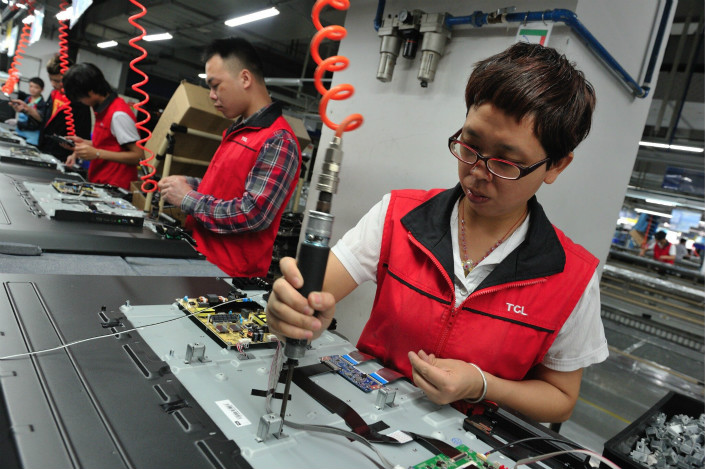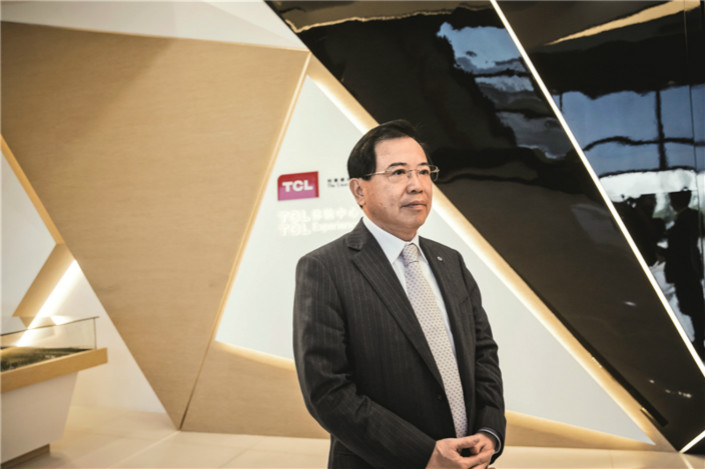Why Did TV Manufacturer Lay Off 10,000 People?

After years of success, Chinese electronics maker TCL Corp. has been rocked by dramatic changes.
The company, which manufactures TVs and other consumer electronics, laid off 10,000 employees — one eighth of its payroll — in early 2017, as part of CEO Li Dongsheng’s attempts to revitalize business in a declining industry.
Traditional television makers have seen shrinking profits in recent years, thanks in part to competition from a new wave of internet-TV innovators.
Li founded TCL’s predecessor company TTK in 1982, and has built it up from a small electronics factory in Huizhou, in Guangdong province. In 2014, TCL’s revenue broke the 100 billion yuan ($15 billion) barrier, making it China’s fourth consumer electronics business to achieve this feat, after Haier Group Corp, Midea Group, and Gree Electric Appliances Inc. of Zhuhai.
But its recent performance has been lackluster. “Revenues hadn’t grown, product premiums hadn’t grown,” Li said. “But the payroll kept getting bigger, and expenses also kept rising.”
Industry-wide decline
TCL first came to prominence during the 1980s and 1990s, when rising urban incomes created huge domestic demand for color TVs. Other big Chinese TV brands also matured during this period, including Changhong, Hisense, Konka, and Skyworth.
Buoyed by low production costs, Chinese companies maintained profit margins of around 15% even during a price war against Japanese brands in the late 1990s. By the early 2000s, the Chinese TV market had developed a relatively stable structure, with Japanese brands dominating the high end, Chinese brands controlling the low, and Korean brands like Samsung and LG in the middle.
 |
TCL CEO Li Dongsheng. Photo: Visual China |
Chinese online video platforms like Tudou, Youku and i-Qiyi — inspired by Youtube — began to emerge around 2005. But TV manufacturers didn’t immediately realize what this meant for their own profits, thanks to a massive consumer-appliance subsidy program launched by the central government in 2008.
The “Appliances to the Countryside” campaign, intended to counter the global financial crisis and expand domestic demand, encouraged rural households to buy appliances such as TVs, refrigerators, and washing machines by offering subsidies. By the time the program ended in January 2013, over 300 million appliances had been purchased across the country with the subsidies — and TCL television sets were among the most popular purchases.
Appliances to the Countryside gave a huge revenue boost to Chinese TV-makers. But it also gave them a false impression of future consumption patterns, and dulled their sensitivity to consumer desires.
Then, not long after Appliances to the Countryside ended, internet companies exploded onto the scene. In July 2013, LeEco introduced a TV combining content, hardware, software, and apps. Soon after, Xiaomi, Whaley, and other internet TV brands followed suit.
The newcomers placed unprecedented pressure on traditional TV makers. In 2014, flat-screen TV sales fell for the first time in many years, and were down 6.7% from the previous year, according to figures from the China Electronics Chamber of Commerce.
“The times have changed, the environment has changed, and the traditional TV business model must change too,” TCL CEO Li said.
Internal problems
Meanwhile, TCL also faced a number of internal problems.
After it acquired French brands Thomson and Alcatel in 2003 and 2005, respectively, TCL suffered net losses for two years in a row, only managing to get back in the black in 2007. Li believes the company’s failed European forays were caused by strategic errors and hurried attempts to achieve quick results internationally.
But at the same time, a subtler, longer-term crisis was brewing. As a large manufacturer with 36 years of history, TCL suffered from increasingly powerful inertia.
“Many departments’ executives were, in fact, incompetent, but their superiors couldn’t bring themselves to find replacements, because the executives had served the company for a very long time,” Li said. These executives were mostly TCL’s founding employees, who had faced many a battle with “Older Brother Dong,” as the younger employees called Li.
Additionally, loyalty and personal connections seemed to be valued over competitiveness when it came to managing personnel at the company. According to a TCL staffer, Older Brother Dong’s favorites don’t face too much pressure, even when they make mistakes — a situation that causes many new hires to lose their sense of responsibility and competitiveness. “If you make a mistake, Brother Dong will, at most, throw a tantrum,” the staffer said. “He’s actually very lenient with his subordinates, so many people who have worked at TCL since they graduated are completely unwilling to leave.”
TCL’s workforce was also rapidly aging. Like many other traditional TV-makers, the top tiers of TCL’s internal hierarchy were dominated by people born before 1980. But at internet firms and in new-economy industries, youth was everywhere.
Dramatic solution
Li’s solution was to take rapid, dramatic action. In the first half of 2017, the company began its biggest round of layoffs ever.
The company’s headquarters cut its staff by 30%, shrinking management expenses by 34%. Its total number of employees fell from 80,000 to 70,000.
TCL is also gradually cutting down its non-core business. Li told Caixin that in the past three years, TCL has cut its involvement in 32 less-relevant subsidiaries that have lower profit margins, giving up controlling stakes in 22 of these businesses.
In March, TCL announced its first internet TV brand, Thunderbird Technology, with an initial range of four TV models. TCL hopes Thunderbird Technology will be able to catch up with internet firms in providing TVs that combine hardware, content, and services.
In July, TCL sold a stake in Thunderbird Technology to social media leader Tencent Holdings Ltd., as part of a smart-TV strategic cooperation.
“This is a disruptive revolution, and the magnitude and scope are unprecedented in TCL,” Li said.
But an industry observer told Caixin that Thunderbird is still too hierarchical, takes too long to make decisions, and is far slower than most internet companies.
Li acknowledges the challenges TCL’s vague business model faces. But “the competitive environment has changed, and we can only adapt, because a single business is unable to change the environment, Li said.
Contact reporter Teng Jing Xuan (jingxuanteng@caixin.com)

- 1PDD Fires Government Relations Staff After Fistfight With Regulators
- 2China Ramps Up Effort to Offload Vast Supply of Unsold Homes
- 3In Depth: China’s Developers Try to Modernize After Surge in Subpar Homes
- 4China’s Elite-Focused Schools Are Failing Most Students, Top Educators Say
- 5In Depth: China Unveils More Nuanced Economic Plan for 2026
- 1Power To The People: Pintec Serves A Booming Consumer Class
- 2Largest hotel group in Europe accepts UnionPay
- 3UnionPay mobile QuickPass debuts in Hong Kong
- 4UnionPay International launches premium catering privilege U Dining Collection
- 5UnionPay International’s U Plan has covered over 1600 stores overseas






